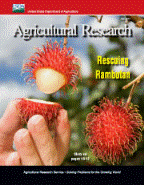United States Department of Agriculture: Agricultural Research Service, Lincoln, Nebraska

Agricultural Research Magazine
Date of this Version
7-2013
Document Type
Article
Citation
Agricultural Research (July 2013)
Abstract
Americans consume about 84 pounds of fresh and processed citrus per person each year, with oranges topping the list at 61 pounds annually. The availability of these favored fruits in grocery stores, fresh markets, and other consumer outlets is a testament to growers’ success in managing the ever-present threat of pests and diseases to the nation’s $3.4 billion citrus crop (2011-12), most of which is produced in Florida and California.
A major threat is citrus greening disease, also known as “Huanglongbing.” First detected in Florida in August 2005, citrus greening today is the target of a multifaceted effort by federal, state, university, and industry partners to control this costly bacterial disease and the insect responsible for spreading it, the Asian citrus psyllid. The most visible symptoms include stunted growth of citrus trees; poor flowering; blotchy, mottled leaves; and off-flavored, misshapen fruit. A diseased tree cannot be cured and starts to decline in 5 to 12 years.
Other hazards, such as droughts, freezes, hurricanes, and earthquakes, can be just as devastating to the citrus industry. Globally, human encroachment on the natural habitat of potentially valuable wild citrus genetic resources is also a concern.
Ensuring Citrus’s Future
Fort Collins, Colorado, is the home of the “Fort Knox” of plant and animal germplasm preservation, the National Center for Genetic Resources Preservation (NCGRP). There, Agricultural Research Service plant physiologist Gayle Volk is spearheading a program to develop methods to back up U.S. citrus cultivars in the form of shoot-tip cuttings that have been cryopreserved—kept in frozen storage via immersion in liquid nitrogen.
The Fort Knox comparison reflects the value of the center’s germplasm collections, which are crucial to research and to food security of current and future generations. The analogy also reflects the structural strength of its large storage vaults, which can withstand flooding, tornado-strength winds, and the impact from a 2,500-pound object hurtled at 125 miles an hour.
Included in
Agriculture Commons, Animal Sciences Commons, Food Science Commons, Plant Sciences Commons

